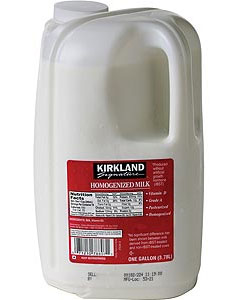 Wal-Mart and Costco have adopted a version of the one-gallon milk jug designed with efficiency in mind. The boxier containers stack better, eliminating the need for milk crates and conserving space in trucks and on refrigerated store shelves:
Wal-Mart and Costco have adopted a version of the one-gallon milk jug designed with efficiency in mind. The boxier containers stack better, eliminating the need for milk crates and conserving space in trucks and on refrigerated store shelves:
The company estimates this kind of shipping has cut labor by half and water use by 60 to 70 percent. More gallons fit on a truck and in Sam’s Club coolers, and no empty crates need to be picked up, reducing trips to each Sam’s Club store to two a week, from five — a big fuel savings. Also, Sam’s Club can now store 224 gallons of milk in its coolers, in the same space that used to hold 80.
The new jugs probably reduce the environmental impact of milk in other important ways. Greater efficiency means less spoilage, which will help to shave down the large carbon footprint associated with dairy farming. Further, the “cold supply chain” is notoriously responsible for leaked refrigerants, which are powerful global warming agents. In addition to reduced energy use, less refrigeration means fewer such pollutants.
Consumers, naturally, hate the new design, ostensibly because of the increased spillage that results from the unfamiliar shape. Shoppers do enjoy the price savings that Wal-Mart is passing along, though, and presumably they’ll warm to the updated packaging. Unwilling to take any chances, the retailer has been running in-store classes on how to operate the new jugs.
The redesigned packaging points at a larger fact about the shifting retail landscape. Wal-Mart’s dominance was built on top of a global supply chain in an age of cheap oil. Some have suggested that the company simply won’t be able to exist in a carbon-constrained world. This has always struck me as not only wrong, but backwards. Wal-Mart’s chief advantage has always been their supply chain efficiency, an advantage they could very well extend as certain natural resources become scarcer.
 Wal-Mart and Costco have adopted a version of the one-gallon milk jug
Wal-Mart and Costco have adopted a version of the one-gallon milk jug 

